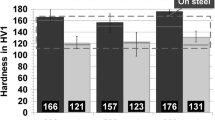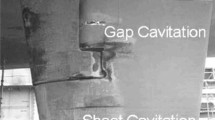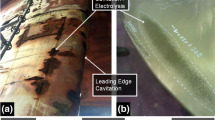Abstract
Within a research project regarding cavitation erosion-resistant coatings, arc spraying was used with different traverse speeds to influence heat transfer and the resulting residual stress state. The major reason for this study is the lack of knowledge concerning the influence of residual stress distribution on mechanical properties and coating adhesion, especially with respect to heterogeneous aluminum bronze alloys. The materials used for spray experiments were the highly cavitation erosion-resistant propeller alloys CuAl9Ni5Fe4Mn (Ni-Al-Bronze) and CuMn13Al8Fe3Ni2 (Mn-Al-Bronze). Analyses of cavitation erosion behavior were carried out to evaluate the suitability for use in marine environments. Further microstructural, chemical and mechanical analyses were realized to examine adhesive and cohesive coating properties. Residual stress distribution was measured by modified hole drilling method using electronic speckle pattern interferometry (ESPI). It was found that the highest traverse speed led to higher tensile residual stresses near the surface and less cavitation erosion resistance of the coatings. Moreover, high oxygen affinity of main alloying element aluminum was identified to severely influence the microstructures by the formation of large oxides and hence the coating properties. Overall, Mn-Al-Bronze coatings showed lower residual stresses, a more homogeneous pore and oxide distribution and less material loss by cavitation than Ni-Al-Bronze coatings.











Similar content being viewed by others
References
Naval Surface Treatment Center, Rudder Coating Failures on Navy Ships (2003), http://www.nstcenter.biz/wp-content/uploads/mdocs/RudderCoatingFailuresNavyShips.pdf. Last Accessed 27 May 2016
“Standard Test Method For Cavitation Erosion Using Vibratory Apparatus”, G32, Annual Book of ASTM Standards, Volume 03.02, ASTM, 2010, p 98-116
J. Carlton, D. Radosavljevic, and S. Whitworth, Rudder-Propeller-Hull Interaction: The Results of Some Recent Research, In-Service Problems and Their Solutions, Proceedings of the First International Symposium on Marine Propulsors—smp’09, K. Koushan and S. Steen, Ed., June 22-24, 2009 (Trondheim, Norway), MARINTEK, 2009, p 262-269
J. Carlton, Propeller Maintenance and Repair, Marine propellers and propulsion, 2nd ed., Butterworth-Heinemann, Oxford, 2007, p 511-519
J.-H. Kim and M.-H. Lee, A Study on Cavitation Erosion and Corrosion Behavior of Al-, Zn-, Cu-, and Fe-Based Coatings Prepared by Arc Spraying, J. Therm. Spray Technol., 2010, 19(6), p 1224-1230
A. Al-Hashem and W. Riad, The Role of Microstructure of Nickel-Aluminium-Bronze Alloy on Its Cavitation Corrosion Behavior in Natural Seawater, Mater. Charact., 2002, 48(1), p 37-41
K.S. Tan, R.J.K. Wood, and K.R. Stokes, The Slurry Erosion Behaviour of High Velocity Oxy-Fuel (HVOF) Sprayed Aluminium Bronze Coatings, Wear, 2003, 255(1-6), p 195-205
S. Krebs, F. Gärtner, and T. Klassen, Cold Spraying of Cu-Al-Bronze for Cavitation Protection in Marine Environments, J. Therm. Spray Technol., 2014, 45(8), p 708-716
J. Pina, A. Dias, and J.L. Lebrun, Study by x-ray Diffraction and Mechanical Analysis of the Residual Stress Generation During Thermal Spraying, Mater. Sci. Eng. A, 2003, 347(1-2), p 21-31
S. Kuroda, T. Fukushima, and S. Kitahara, Significance of Quenching Stress in the Cohesion and Adhesion of Thermally Sprayed Coatings, J. Therm. Spray Technol., 1992, 1(4), p 325-332
S. Sampath, X.Y. Jiang, J. Matejicek, L. Prchlik, A. Kulkarni, and A. Vaidya, Role of Thermal Spray Processing Method on the Microstructure, Residual Stress and Properties of Coatings: An Integrated Study for Ni-5 wt.%Al Bond Coats, Mater. Sci. Eng. A, 2004, 364(1-2), p 216-231
T.W. Clyne and S.C. Gill, Residual Stresses in Thermal Spray Coatings and Their Effect on Interfacial Adhesion: A Review of Recent Work, J. Therm. Spray Technol., 1996, 5(4), p 401-408
Y.X. Chen, X.B. Liang, Y. Liu, S.C. Wei, and B.S. Xu, Effect of Heat Treatment on Microstructure and Residual Stress of Wire Arc Sprayed High Carbon Steel Coating, Surf. Eng., 2010, 26(6), p 407-412
Y.X. Chen, X.B. Liang, Y. Liu, and B.S. Xu, Effect of Path-Plans of Automatic Arc Spraying on Coating Residual Stresses, Trans. China Weld. Inst., 2010, 31(8), p 97-100 (in Chinese)
J. Chi, A. Zhang, S. Xie, and C. Jin, Process Optimization and Residual Stress Measurement for Arc Spraying Rapid Tooling, Acad. J. Xi’an Jiaotong Univ., 2014, 48(12), p 126-130 (in Chinese)
H.J. Meigh, Cast and Wrought Aluminium Bronzes: Properties, Processes and Structure, Copper Development Association/IOM Communications, London, 2000, p 3-31/p 293-351
M. Steinzig and E. Ponslet, Residual Stress Measurement Using the Hole Drilling Method and Laser Speckle Interferometry: Part I, Exp. Tech., 2003, 27(3), p 43-46
G.S. Schajer and M. Steinzig, Full-Field Calculation of Hole-Drilling Residual Stresses from Electronic Speckle Pattern Interferometry Data, Exp. Mech., 2005, 45(6), p 526-532
Acknowledgments
The authors would like to thank all co-workers involved in the study, namely listed in alphabetical order: R. Arndt, A. Herhaus, C.-P. Homburg, D. Krüger, R. Lange, N. Németh, B. Ripsch, A. Schober, M. Schulze, K. Utwich and S. Wachtmann. The research project (No. 18449 BG) of the research community Center of Maritime Technologies (CMT), Bramfelder Straße 164, 22305 Hamburg, has been funded by the AiF within the program for sponsorship by Industrial Joint Research (IGF) of the German Federal Ministry of Economic Affairs and Energy based on an enactment of the German parliament. This support is greatly acknowledged.
Author information
Authors and Affiliations
Corresponding author
Additional information
This article is an invited paper selected from presentations at the 2016 International Thermal Spray Conference, held May 10-12, 2016, in Shanghai, People’s Republic of China, and has been expanded from the original presentation.
Rights and permissions
About this article
Cite this article
Hauer, M., Henkel, K.M., Krebs, S. et al. Study of Traverse Speed Effects on Residual Stress State and Cavitation Erosion Behavior of Arc-Sprayed Aluminum Bronze Coatings. J Therm Spray Tech 26, 217–228 (2017). https://doi.org/10.1007/s11666-016-0446-0
Received:
Revised:
Published:
Issue Date:
DOI: https://doi.org/10.1007/s11666-016-0446-0




